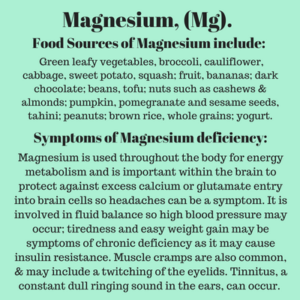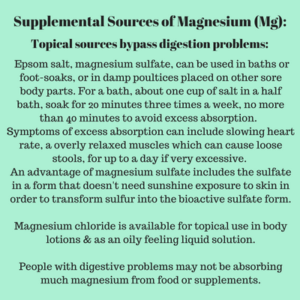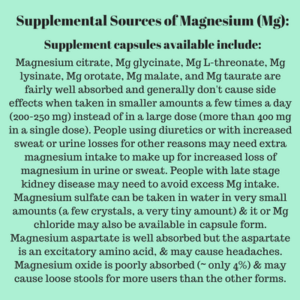Good news and bad news – magnesium in the form of Epsom salt, magnesium sulfate, has been in use medicinally since the seventeenth century and written about in peer reviewed medical journals since the early nineteenth century. (1) That is both the good and bad news – it is helpful, but it still isn’t used for many conditions where it might be needed. It is not patentable as a pharmaceutical medication because it is a natural substance. It or magnesium chloride and some other forms are in use for a few conditions including preeclampsia, migraines, stroke, and traumatic brain injury. Minor athletic injuries may be treated with Epsom salt soaks (3) and some psychiatric care providers may also recommend the treatment.
A textbook on the topic of magnesium use for medical conditions reviews the mineral’s role in the body during health and chronic illness or when genetic differences in metabolism are present. It is complex metabolically and just taking a supplement doesn’t always get magnesium to the problem area of the body. Magnesium is primarily found within cells, and most is bound to proteins or phospholipids (such as adenosine triphosphate, ATP) rather than as free ions, in blood plasma or other extracellular fluid and not all forms can cross the blood brain barrier to help with migraines or other brain injuries. (1) Magnesium sulfate and magnesium chloride have been found helpful for those purposes (1) and both can be used topically which can bypass problems with poor absorption in the digestive system. (3)
“Intracellular magnesium concentrations range from 5–20 mmol/L; 1%–5% is ionized, the remainder is bound to proteins, negatively charged molecules and adenosine triphosphate (ATP) [14,15].” (6)
Magnesium oxide is a form sometimes used in supplements that has been found to be very poorly absorbed even when the digestive system is in normal health. Only four percent of a dose is likely to be absorbed and the remaining 96% tends to cause loose stools by causing the intestinal muscles to relax too much if the supplement is in a larger dose. (1) Math – a 250 mg supplement of magnesium oxide might only have 10 milligrams absorbed and 240 milligrams pass through in the next bowel movement.
Magnesium aspartate has been found helpful in some research studies, but the aspartate is an excitatory amino acid that can cause overactivity within brain cells possibly even leading to cell death, so it may not be ideal for people with some conditions such as headaches or brain injury. Other forms of supplements found to typically be well absorbed include magnesium citrate and magnesium glycinate. More recent research is using magnesium threonate as a form that may be more likely to be absorbed through the blood brain barrier. (1)
Summary points:
Symptoms of deficiency may include:
- Headaches or migraines may be a symptom because magnesium is used within the brain to protect against excess calcium or glutamate entry into brain cells. It is involved in fluid balance so high blood pressure may occur; tiredness and easy weight gain may be symptoms of chronic deficiency as it may cause insulin resistance and is essential within metabolism to turn sugar into a form of usable energy. Muscle cramps are also a common symptom of magnesium deficiency and may include a twitching of the eyelids. Tinnitus, a constant dull ringing sound in the ears, can occur. (1) (2)
Food sources of magnesium include:
- Green leafy vegetables, broccoli, cauliflower, cabbage, sweet potato, squash; fruit, bananas; dark chocolate; beans, tofu; nuts such as cashews & almonds; pumpkin, pomegranate and sesame seeds, tahini; peanuts; brown rice, whole grains; yogurt. (2)

Topical sources of magnesium include:
- Epsom salt, magnesium sulfate, can be used in baths or foot-soaks, or in damp poultices placed on other sore body parts. For a bath, about one cup of salt in a half bath, soak for 20 minutes three times a week, no more than 40 minutes to avoid excess absorption.
Symptoms of excess absorption can include slowing heart rate, an overly relaxed muscles which can cause loose stools, for up to a day if very excessive. (3)
An advantage of magnesium sulfate includes the sulfate in a form that doesn’t need sunshine exposure to skin in order for the body to be able to transform sulfur found in foods into the bioactive sulfate form.- Epsom Salt Cream is a new product. The website mentions that the bioactive sulfate may help with detoxification of heavy metals, and improve digestion and socialization, if low sulfate was causing the symptoms. (8)
- Magnesium chloride is available for topical use in body lotions & as an oily feeling liquid solution.People with digestive problems may not be absorbing much magnesium from food or supplements.
- The magnesium ions are not absorbed directly through the layers of skin cells. Entry into the body has been found to occur through the openings provided by hair follicles. (5)

Supplemental forms of magnesium may include:
-
- Magnesium citrate, Mg glycinate, Mg L-threonate, Mg lysinate, Mg orotate, Mg malate, and Mg taurate are all fairly well absorbed forms and generally don’t cause side effects when taken in smaller amounts a few times a day (200-250 mg) instead of in a large dose (more than 400 mg in a single dose). People using diuretics or with increased sweat or urine losses for other reasons may need extra magnesium intake to make up for increased loss of magnesium in urine or sweat. People with late stage kidney disease may need to avoid excess Mg intake. (1) (4)
-
Magnesium Glycerophosphate is a newer supplemental form that may be a well absorbed form with less risk of a diarrhea/loose stools side effect. The glycerophosphate can also be used by the body to form ATP, a molecule needed for energy formation within cells. (7)
- Magnesium sulfate can be taken in water in very small amounts (a few crystals, a very tiny amount) (3), & it or Mg chloride may also be available in capsule form.
Magnesium aspartate is well absorbed but the aspartate is an excitatory amino acid and may cause headaches for some users.
- Magnesium oxide is poorly absorbed (~ only 4%) & may cause loose stools for more users than the other forms. (1)

Food Sources of Phospholipids and other phospho-nutrients:
Hemp seed kernels and oil; Artemisia turanica/wormwood leaf; amaranth seed; asparagus; avocado fruit or the inner kernel, dried and powdered; beans/legumes; cardamom seeds and powder; carrots; celery stalks and leaves; cocoa beans and cocoa powder, baker’s chocolate, dark chocolate and to a lesser amount milk chocolate and chocolate syrup; coconut; cumin seed/powder; fennel seed, flax seed, pine nuts; sesame seeds, pumpkin seed kernels, squash seeds; butternut squash and pumpkin; gingko leaf; grapefruit and orange juice with the pulp; Jerusalem artichoke (this is a root vegetable rather than a green artichoke); lettuce, spinach and mustard leaves and other leafy green vegetables and herbs; nuts/peanuts, cashews, walnuts; oats; okra seeds; onion root, leek leaves, garlic; parsnip root; pomegranate seeds and pomegranate peel extract;rice, white or brown but the bran is the best source; rosemary; sorghum; sweet potato or yam; buckwheat (a seed botanically that is not wheat and is gluten free); wheat. (G.26)
More information about protein and water needs are available in a post about kidney health: Make every day Kidney Appreciation Day.
/Disclosure: This information is provided for educational purposes within the guidelines of fair use. While I am a Registered Dietitian this information is not intended to provide individual health guidance. Please see a health professional for individual health care purposes./
- Robert Vink, Mihai Nechifor, editors, Magnesium in the Central Nervous System, University of Adelaide Press, 2011, adelaide.edu.au, free ebook pdf, https://www.adelaide.edu.au/press/titles/magnesium/magnesium-ebook.pdf (1)
- Rachael Link, MS, RD,Top 10 Magnesium-rich Foods, Plus Proven Benefits, DrAxe.com, https://draxe.com/magnesium-deficient-top-10-magnesium-rich-foods-must-eating/ (2)
- Magnesium sulfate (Epsom salt) – Side Effects Dosage, Interactions, everydayhealth.com https://www.everydayhealth.com/drugs/magnesium-sulfate (3)
- Magnesium Types Compared: What is the Best Magnesium for You?, swansonvitamins.com, https://www.swansonvitamins.com/blog/chelsea/magnesium-types-compared (4)
- Chandrasekaran NC, Sanchez WY, Mohammed YH, et al., Permeation of topically applied Magnesium ions through human skin is facilitated by hair follicles., Magnes Res. 2016 Jun 1;29(2):35-42.
https://www.ncbi.nlm.nih.gov/pubmed/27624531 (5) - Uwe Gröber, Joachim Schmidt, and Klaus Kisters, Magnesium in Prevention and Therapy, Nutrients. 2015 Sep; 7(9): 8199–8226.
https://www.ncbi.nlm.nih.gov/pmc/articles/PMC4586582/ (6) - Prof. Gene Bruno, Magnesium Glycerophosphate: Magnesium for Cardiovascular & Muscular Health. Nov. 1, 2018, naturalpractitionermag.com, https://naturalpractitionermag.com/magnesium-glycerophosphate-magnesium-for-cardiovascular-muscular-health/
- Magnesium Sulfate Cream from Kirkman, kirkmangroup.com, http://www.kirkmangroup.com/magnesium-sulfate-cream-113-gm-4-oz.html
